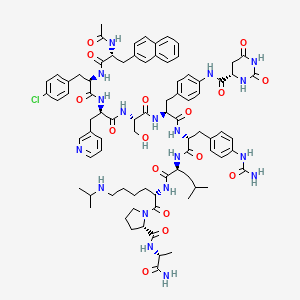Degarelix is a medication used in the treatment of advanced prostate cancer. It belongs to a class of drugs known as gonadotropin-releasing hormone (GnRH) receptor antagonists. Degarelix blocks the action of GnRH, suppressing the production of testosterone in the body. By reducing testosterone levels, degarelix helps slow down the growth and spread of prostate cancer cells. It is typically administered as an injection and is prescribed under medical supervision. As with any medication, it is important to consult a healthcare professional for proper usage and potential side effects.
Degarelix Structure
- Chemical Name: Degarelix
- Sequence: Ac-D-2Nal-D-4Cpa-D-3Pal-Ser-4Aph(L-Hor)-D-4Aph(Cbm)-Leu-Lys(iPr)-Pro-D-Ala-NH2
- Molecular Formula: C82H103ClN18O16
- Molecular Weight: 1632.36 grams/mole
- PubChem CID: 16132541
- CAS Number: 214766-78-6
- Synonyms: Degarelix acetate, FE200486, FE-200486, FE 200486

Source: PubChem
How does Degarelix work?
Degarelix works by blocking the action of a hormone called gonadotropin-releasing hormone (GnRH) in the body. GnRH is responsible for stimulating the production of luteinizing hormone (LH) and follicle-stimulating hormone (FSH) in the pituitary gland.
In the context of prostate cancer, these hormones can stimulate the growth of cancer cells. By blocking the GnRH receptors, degarelix prevents the release of LH and FSH, which in turn reduces the production of testosterone in the testes.
Testosterone is an androgen hormone that can promote the growth of prostate cancer cells. By lowering testosterone levels, degarelix helps to slow down the progression and spread of prostate cancer.
Unlike other hormonal therapies, which initially cause a surge in hormone levels before suppressing them, degarelix rapidly and effectively suppresses the production of these hormones without an initial surge. This can provide quick relief from symptoms associated with advanced prostate cancer and help control the growth of cancer cells.
It's important to note that degarelix is typically administered as an injection and is prescribed and monitored by a healthcare professional. The dosage and treatment schedule may vary depending on individual circumstances.
How does Degarelix work?
Degarelix, a medication used in the treatment of prostate cancer, offers several benefits. Here are some of the key advantages:
Effective reduction of testosterone levels
Degarelix is a gonadotropin-releasing hormone antagonist that rapidly and effectively reduces testosterone levels in the body. By suppressing testosterone, it can help slow down the growth and progression of prostate cancer.
Improved disease control
Studies have shown that degarelix improves disease control compared to other hormonal therapies like LHRH agonists. It has demonstrated superior PSA progression-free survival rates, indicating better control over the cancer's progression.
Well-tolerated with fewer side effects
Degarelix is generally well-tolerated and has a lower risk of causing systemic allergic reactions compared to certain other treatments. It does not cause a testosterone surge during the initial phase of treatment, which can be seen with some other hormonal therapies.
Potential for chemical castration
Due to its mechanism of action as a hormone antagonist, degarelix can be considered an option for chemical castration in the treatment of prostate cancer. It helps to suppress the production of testosterone, which is essential for the growth and development of prostate cancer cells.
Comparable cardiovascular safety
Studies have indicated that degarelix has cardiovascular safety profiles similar to leuprolide, another common hormonal therapy for prostate cancer. This suggests that degarelix may not pose additional cardiovascular risks compared to other treatment options.
It's important to note that the benefits and suitability of degarelix may vary depending on individual patient factors, stage of prostate cancer, and other treatment considerations.
Potential Side-Effects
While degarelix is generally well-tolerated, it can have potential side effects like any medication. It's important to note that not everyone will experience these side effects, and individual reactions may vary. Some potential side effects of degarelix may include:
Injection site reactions: Pain, redness, swelling, or itching at the injection site are common side effects of degarelix. These reactions are usually mild to moderate and temporary.
Hot flashes: Hot flashes, characterized by sudden feelings of warmth and sweating, are a common side effect of degarelix. This can be managed with lifestyle changes or medications.
Fatigue: Some individuals may experience fatigue or tiredness while taking degarelix. It is advisable to rest when needed and engage in activities that promote relaxation.
Decreased libido or erectile dysfunction: Degarelix may cause a decrease in libido (sex drive) or erectile dysfunction in some individuals. Discussing these concerns with a healthcare professional is important for possible solutions.
Gastrointestinal issues: This medication can sometimes cause gastrointestinal side effects such as nausea, diarrhea, or constipation. Maintaining a balanced diet and staying hydrated can help alleviate these symptoms.
Changes in liver function: Rare cases of changes in liver function, including elevated liver enzymes, have been reported with degarelix. Regular monitoring may be recommended in certain individuals.
It's crucial to consult with a healthcare professional for a comprehensive understanding of potential side effects associated with degarelix. They can provide personalized guidance, address concerns, and monitor your response to the medication.
Other Uses for Degarelix
Degarelix is primarily used for the treatment of prostate cancer. However, it's important to note that medications can sometimes have off-label uses, meaning they may be prescribed for conditions other than their primary approved indication. While off-label use should always be determined and discussed with a healthcare professional, some potential off-label uses of degarelix are being explored. These include:
Endometriosis: Degarelix has shown promise in treating endometriosis, a condition where tissue similar to the lining of the uterus grows outside the uterus. It may help reduce pain and inflammation associated with endometriosis.
Uterine fibroids: Some studies have suggested that degarelix might have a role in the treatment of uterine fibroids, noncancerous growths that develop in the uterus. It may help shrink the size of fibroids and alleviate symptoms such as heavy menstrual bleeding.
It's crucial to point out that the use of degarelix for these conditions is still being investigated, and more research is needed to determine its safety and effectiveness.
Sources:
https://www.cancer.org/cancer/types/prostate-cancer/treating/hormone-therapy.html
https://www.cancer.gov/types/prostate/hp/prostate-treatment-pdq
https://www.ncbi.nlm.nih.gov/pmc/articles/PMC3547532/
https://www.ncbi.nlm.nih.gov/pmc/articles/PMC7171911/
